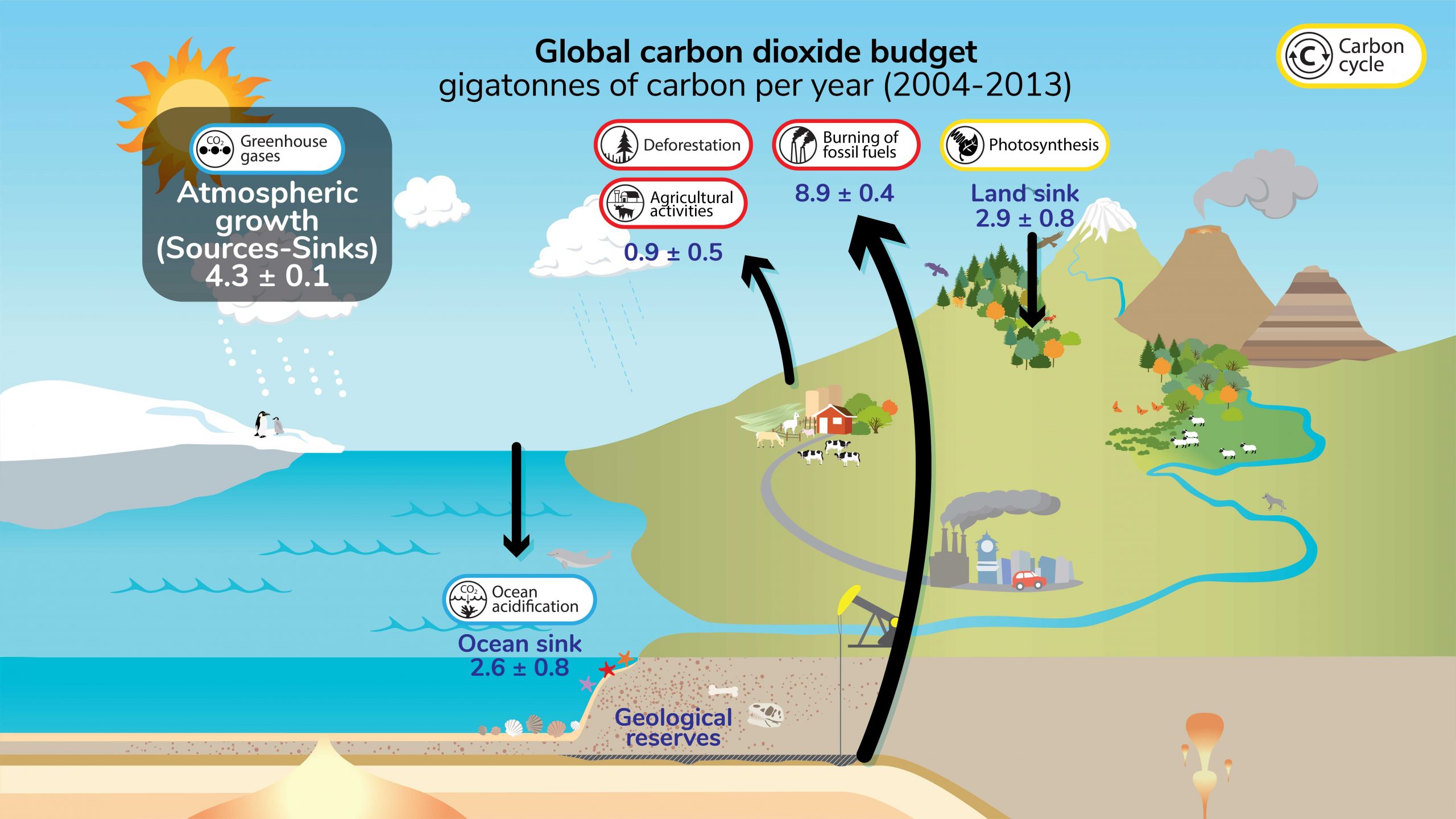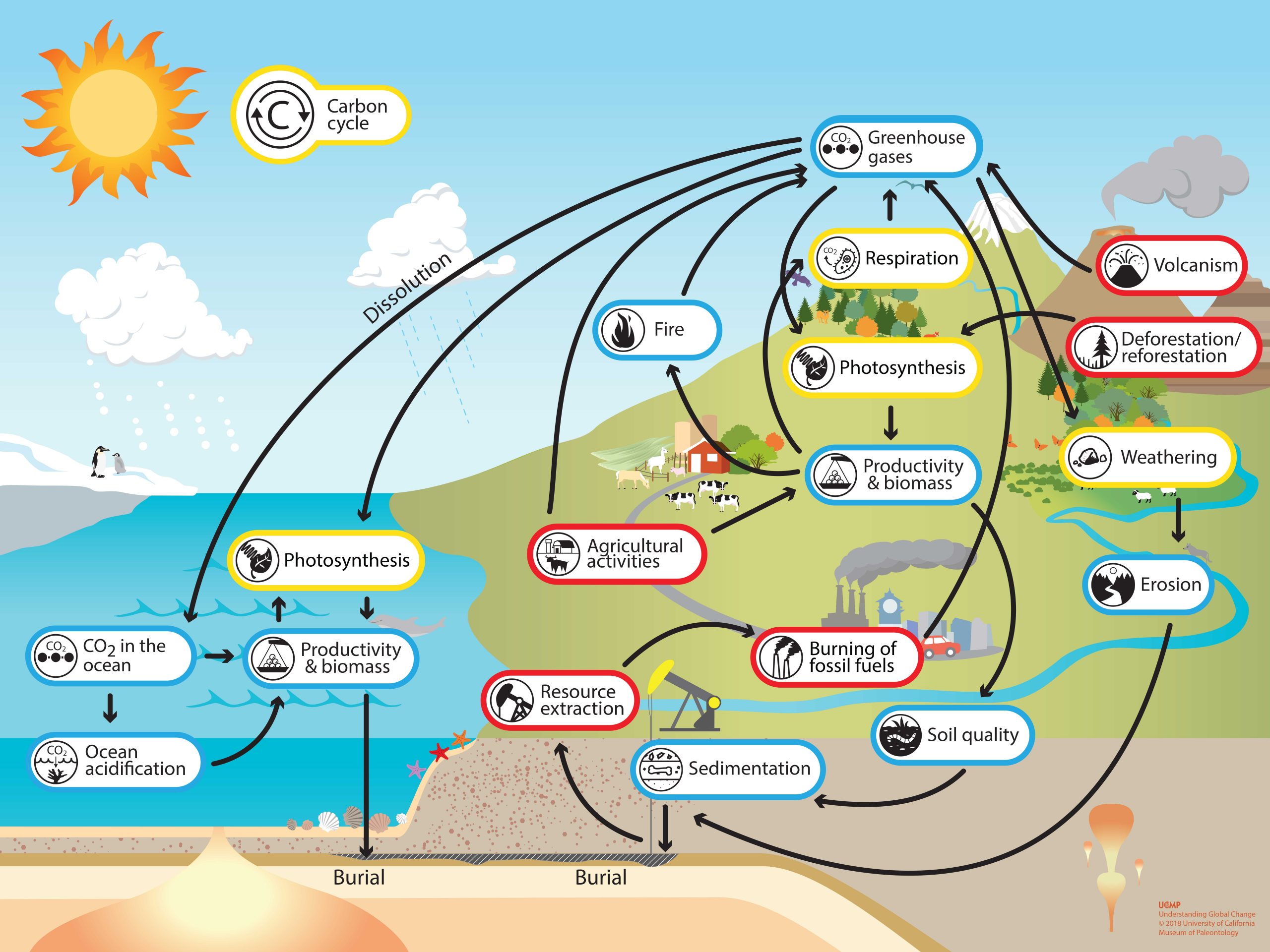How Can Carbon Get From The Atmosphere To The Hydrosphere

While most of the Earth's carbon can exist found in the geosphere, carbon is establish in all living things, soils, the ocean, and atmosphere. Carbon is the primary building block of life, including Deoxyribonucleic acid, proteins, sugars and fats. One of the most important carbon compounds in the atmosphere is carbon dioxide (CO2), while in rocks carbon is major component of limestone, coal, oil and gas. Carbon cycles through the atmosphere, biosphere, geosphere, and hydrosphere via processes that include photosynthesis, burn down, the called-for of fossil fuels, weathering, and volcanism. By understanding how human activities take altered the carbon cycle, we tin can explain many of the climate and ecosystem changes we are experiencing today, and why this rapid rate of alter is largely unprecedented in the Earth'south history.
What is the carbon bike?
Carbon is transferred between the body of water, temper, soil, and living things over time scales of hours to centuries. For instance, photosynthesizing plants on land remove carbon dioxide directly from the atmosphere, and those carbon atoms go part of the structure of the plants. Every bit plants are eaten past herbivores and herbivores are eaten by carnivores, carbon moves up the food web. Meanwhile, the respiration of plants, animals, and microbes returns carbon to the atmosphere every bit carbon dioxide (CO2). When organisms dice and decay carbon also returns to the temper, or is integrated into soil forth with some of their waste matter. The combustion of biomass during wildfires also release large amounts of carbon stored in plants back into the temper.
On longer timescales, significant amounts of carbon are transferred betwixt rocks and the ocean and atmosphere, typically over thousands to millions of years. For example, the weathering of rocks removes carbon dioxide from the temper. The resulting sediments, along with organic material, tin be transported (eroded) from the land to enter the ocean where they sink to the lesser. This carbon from state, also as carbon atoms in COtwo absorbed by the ocean from the atmosphere, tin go incorporated into calcium carbonate (CaCOthree) shells made by algae, plants, and animals. These shells become buried. As the successive layers of sediment are compressed and cemented they are turned into limestone rock. Over millions of years these carbon-bearing rocks can exist exposed to sufficient heat and pressure to melt, causing them to release their carbon back into the temper as carbon dioxide via volcanism. Some of these rocks volition as well be exposed at the surface of the Earth through mountain edifice and weathering, and the cycling begins again. Carbon from the mantle (come across plate tectonics) is also released into the atmosphere every bit carbon dioxide through volcanic action.
Carbon is also transferred to rocks from the biosphere, via the formation of fossil fuels, which form over millions of years. Fossil fuels are derived from the burying of photosynthetic organisms, including plants on land (which primarily forms coal) and plankton in the oceans (which primarily forms oil and natural gas). While buried, this carbon is removed from the carbon cycle for millions of years to hundreds of millions of years.
Human activity, especially the burning of fossil fuels, has dramatically increased the exchange of carbon from the ground back into the atmosphere and oceans. This return of carbon dorsum into atmosphere as carbon dioxide is occurring at a rate that is hundreds to thousands of times faster than it took to bury it, and much faster than it can be removed past the carbon bike (for example, by weathering). Thus, the carbon dioxide released from the burning of fossil fuels is accumulating in the atmosphere, increasing average temperatures through the greenhouse effect, as well as dissolving in the body of water, causing body of water acidification.

A simplified diagram showing some of the ways carbon dioxide moves through the World system, and the overall increment in atmospheric carbon dioxide from 2004-2013.
The rate of exchange and the distribution of carbon in the Earth organization is affected by diverse human being activities and environmental phenomena, including:
- The called-for of fossil fuels, which rapidly releases carbon dioxide (CO2), a greenhouse gas into the atmosphere, increasing average global temperatures and causing ocean acidification.
- Agricultural activities that release carbon dioxide and methane (CH4, a greenhouse gases) into the atmosphere. For instance, marsh gas is produced from the digestion of plant cloth past cows, and from the bacteria that thrive in rice fields. Carbon dioxide is released from the burning of fossil fuels to power farming equipment, from the mining of minerals and the making of fertilizer. The growing of crops and the raising of livestock also affects local productivity and biomass, and rates of photosynthesis, respiration, and disuse of organic cloth.
- Deforestation, which decreases rates of photosynthesis and thus how much carbon dioxide is captured by the growth of plants. When trees grow they accept carbon dioxide out of the temper and transfer it into their wood, leaves, bark and roots. The carbon is returned to the atmosphere when downed copse are left to rot, or if the trees are intentionally prepare on burn down, which is a common means of deforestation. Thus, deforestation typically releases carbon dioxide, unless all the material is used for construction, or for paper products.
- The extent of permafrost (soil that is frozen all year round), which contains methane (CH4, a greenhouse gas). When temperatures remain cold all year-circular organic material decays very slowly, and it remains in the soil. The melting of permafrost, which is happening every bit global temperatures increment, releases methane. The increasing temperatures as well increase rates of decay, which further increases the corporeality of greenhouse gases in the atmosphere.
- Over millions of years changes in the rate of sedimentation and rate of burial of organic matter alters the amount of carbon available for disuse and how much carbon is stored in the stone record. For case, increased burial of dead plants and plankton decreases disuse thereby increasing the rate of formation of fossil fuels.
- Over millions of years, processes in the rock cycle can modify carbon dioxide levels in the atmosphere. For example, the metamorphic reactions that occur under heat and pressure tin release carbon dioxide. In contrast, the weathering of rocks that occurs when carbon dioxide dissolves into rainwater to form carbonic acid (HtwoCO3) reduces the amount of carbon dioxide in the atmosphere. Warming can increase these weathering reactions, but not at a charge per unit that can offset the increase in carbon dioxide due to homo activities.
- Geologic changes in the charge per unit of volcanism, driven past plate tectonics, tin dramatically modify the amount of carbon dioxide in the atmosphere, but on timescales much longer than homo timescales, over millions of years.
World system model about the carbon cycle
The Earth arrangement model below includes some of the processes and phenomena related to the carbon bike. These processes operate at various rates and on dissimilar spatial and temporal scales. For example, carbon is transferred among plants and animals over relatively short time periods (hours-weeks), but the human extraction and burning of fossil fuels has altered the carbon bicycle over decades. Additionally, processes that include weathering and volcanism affect the carbon cycle over millions of years. Tin yous think of additional crusade and effect relationships betwixt the parts of the carbon cycle and other processes in the Earth organization?
Explore the Earth System
Click the bolded terms (east.g. burning of fossil fuels , greenhouse event, and weathering) on this page to learn more nigh these procedure and phenomena. Alternatively, explore the Understanding Global Modify Infographic and observe new topics that are of involvement and/or locally relevant to you.
Links to Learn More
- NASA Earth Observatory: The Carbon Wheel
- UCAR: The Carbon Cycle
- NOAA: The Carbon Bike
Source: https://ugc.berkeley.edu/background-content/carbon-cycle/#:~:text=Carbon%20cycles%20through%20the%20atmosphere,fuels%2C%20weathering%2C%20and%20volcanism.

0 Response to "How Can Carbon Get From The Atmosphere To The Hydrosphere"
Post a Comment